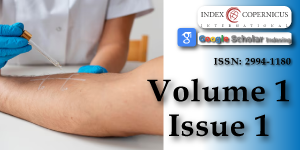Clinical significance of Vibration Anesthesia on reducing pain of Ring-Block (Subcutaneous Injections) in the patients undergoing Hair Restoration Surgery
Main Article Content
Article Details
Copyright (c) 2017 Ahmad M, et al.

This work is licensed under a Creative Commons Attribution 4.0 International License.
Dubner R, Sesele BJ, Storey AT. The neural basis of oral and facial function. New York: Plenum. 1978. 1979; 75: 695. Ref: https://goo.gl/JK63qN
Moayedi M, Davis KD. Theories of pain from specificity to gate control. J Neurophysiol. 2013; 109: 5-12. Ref: https://goo.gl/ZrRAQP
Melzack R, Wall PD. Pain mechanisms: a new theory. Science. 1965; 150: 971-979. Ref: https://goo.gl/vbeHwh
Nanitsos E, Vartuli R, Forte A, Dennison PJ, Peck CC. The effect of vibration on pain during local anaesthesia injections. Aust Dent J. 2009; 54: 94-100. Ref: https://goo.gl/Gr5gF9
Shahidi Bonjar AH. Syringe micro vibrator (SMV) a new device deing introduced in dentistry to alleviate pain and anxiety of intraoral injections and a comparative study with a similar device. Ann Surg Innov Res. 2011; 5: 1. Ref: https://goo.gl/sNxbgB
Nasehi A, Bhardwaj S, Kamath AT, Gadicherla S, Pentapati KC. Clinical pain evaluation with introral vibration device during local anaesthetic injections. J Clin Exp Dent. 2015; 7: 23-27. Ref: https://goo.gl/7E8qSt
Sharma P, Czyz CN, Wulc AE. Investigating the efficacy of vibration anaesthesia to reduce pain from cosmetic Botulinum toxin injections. Aesthet Surg J. 2011; 31: 966-971. Ref: https://goo.gl/tbjToJ
Ahmad M, Mohmand MH. Use of vibration anaesthesia in hair restoration surgery. J Pak Assoc Dermatol. 2017; 27.
Ref.: https://goo.gl/lg5y3n .
Johansson RS, Landstrom U, Lundstrom R. Responses of mechanoreceptive afferent units in the glabrous skin of the human hand to sinusoidal skin displacements. Brain Res. 1982; 244: 17-25. Ref: https://goo.gl/yCFH2A
Hasan Z, Houk AC. Analysis of response properties of deeferented mammalian spindle receptors based on frequency response. J Nerophysiol. 1975; 38: 663-672. Ref: https://goo.gl/w537Un
Kohn T, Zari S. Local anaesthesia techniques in hair restoration surgery. J Cut Med Surg. 2016; 20: 610-612. Ref: https://goo.gl/8mp4pt
Seager DJ, Simmons C. Local anaesthesia in hair transplantation. Dermatol Surg. 2002; 28: 320-328. Ref: https://goo.gl/q7Ncwo
Cem Ungor1, Emre Tosun, Ezher Hamza Dayisoylu, Fatih Taskesen, Figen Cizmeci Senel. The effects of vibration on pain and anxiety during local anaesthesia administration. JSM Dent. 2014; 2: 1022. Ref: https://goo.gl/UwPGr5
Fayers T, Morris DS, Dolman PJ. Vibration-assisted anaesthesia in eyelid surgery. Ophthalmology. 2010; 117: 1453-1457. Ref: https://goo.gl/wTK4LF
Muhammad Ahmad, Humayun Mohmand. Nerve blocks or subcutaneous injections: comparison of pain levels in patients undergoing hair transplant surgery. Pak J Plast Surg 2015; 4:19-22. Ref: https://goo.gl/y7fT3E

